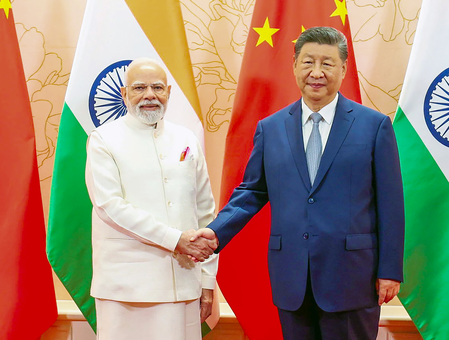New Delhi- In today’s changing geopolitical landscape, global attention has been drawn to US President Donald Trump’s reaction to the Shanghai Cooperation Organisation (SCO) summit in Tianjin, China (Aug 31–Sep 1, 2025), India’s ties with the US and Russia, and China’s rise as a counterweight to American power.
Prime Minister Narendra Modi’s visit to China for the SCO summit included one-on-one meetings with Chinese President Xi Jinping and Russian President Vladimir Putin, reflecting India’s policy of engaging major powers while maintaining strategic autonomy. India’s participation at the highest level reinforced its commitment to safeguarding national interests by diversifying trade partnerships and projecting its sovereignty in global affairs.
Russia, meanwhile, played its familiar role as a balancing power between the US and China, a theme that stood out at the Tianjin meet. India also sent a message to Washington that tariff pressures would not derail its pursuit of independent economic and trade policies.
Beijing’s Parade and Global Optics
Overshadowing the SCO summit itself was the grand military parade in Beijing on September 3, marking the 80th anniversary of Japan’s surrender in World War II. The sight of Xi Jinping, Vladimir Putin, and North Korean leader Kim Jong Un walking together underscored a powerful display of unity. Putin addressed Kim as “Dear Chairman of State Affairs” and acknowledged North Korea’s support for Russia in Ukraine. He also pledged cooperation with China in nuclear power, further strengthening the anti-US bloc narrative.
Trump responded by accusing Xi of “conspiring against the US,” while Putin dismissed this as Trump’s “sense of humour.” Putin reiterated his willingness for peace talks with Ukraine, but also warned he would resort to force if diplomacy failed.
India-China Dynamics
For India, Modi’s first China visit in seven years yielded incremental gains in repairing strained ties post-Galwan. He emphasized that bilateral relations should not be viewed “through the lens of a third country,” while Xi stressed that border disputes must not derail progress. Both sides signaled resistance to Trump’s unilateral tariff measures.
India’s approach reflects a dual-track strategy: maintaining vigilance against Chinese assertiveness while keeping doors open for dialogue and cooperation.
Navigating a Multipolar World
India’s broader foreign policy continues to emphasize multipolarity, strategic autonomy, and non-alignment. With Indo-US trade negotiations temporarily stalled over tariffs, Commerce Minister Piyush Goyal remains hopeful of a breakthrough. Trump, while insisting on punitive tariffs, simultaneously remarked that “we get along with India very well.”
On energy, India continues oil imports from Russia despite US pressure, highlighting its independent stance. Meanwhile, diversification of trade ties with Europe, the Global South, and Eurasia underscores India’s pragmatic diplomacy.
Strategic Takeaway
Modi’s SCO summit visit was not expected to dramatically transform India-China relations, given persistent distrust over border disputes, China’s support for Pakistan, and its growing regional footprint. Yet, India’s ties with the US-Russia axis remain resilient, while Trump’s criticism of SCO is largely seen as a reaction to China’s bid for superpower status.
This evolving triangle—India, Russia, and the US—offers New Delhi an opportunity to strengthen its global standing. In this environment of shifting alliances, India’s smart diplomacy and strategic patience will be key to safeguarding national interests and advancing its position as a major world power.
(The writer is a former Director, Intelligence Bureau)
–IANS

